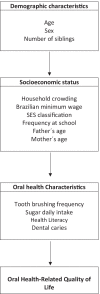Relationship between oral health literacy of caregivers and the oral health-related quality of life of children: a cross-sectional study
- PMID: 35907863
- PMCID: PMC9338565
- DOI: 10.1186/s12955-022-02019-4
Relationship between oral health literacy of caregivers and the oral health-related quality of life of children: a cross-sectional study
Abstract
Background: Oral health literacy is the degree to which individuals have the capacity to obtain, process, and understand basic health information and services needed to make appropriate oral health decisions. However, scientific evidence about the oral health literacy of caregivers and the children's oral health-related quality of life. The purpose of this study was to verify the relationship between the level of oral health literacy of caregivers and the children's oral health-related quality of life (OHRQOL).
Methods: This study was conducted with children aged 2 to 4 in Diadema, São Paulo, Brazil. Six hundred thirty children were examined to assess the prevalence of dental caries (dmft index). Parents were interviewed to obtain sociodemographic status, oral conditions, and oral health literacy (OHL). The variable outcome was the children's OHRQOL as assessed by the Early Childhood Oral Health Impact Scale (ECOHIS). We fitted zero-inflated negative binomial regression (ZINB) models to evaluate associations between the study outcome and covariates in terms of PR (Prevalence Ratios), RR (Rate Ratios), and their respective Confidence Intervals (95% CI).
Results: Children's OHRQOL was not associated with OHL. Dental caries had a negative impact on the children's quality of life (p < 0.05). A reduced impact on OHRQOL is also associated with having siblings (PR = 0.70, 95% CI 0.52-0.95). A higher age of the mother reduced OHRQOL impacts (PR = 0.72, 95% CI 0.52-0.98).
Conclusions: The factors associated with children's OHRQOL were the number of siblings, the mothers' age, and dental caries. This study observed no association between parental OHL and children's OHRQOL.
Keywords: Dental caries; Oral health literacy; Oral health-related quality of life; Preschool-age children.
© 2022. The Author(s).
Conflict of interest statement
The authors declare that they have no competing interests.
Figures
References
-
- Mattheus DJ. Vulnerability related to oral health in early childhood: a concept analysis. J Adv Nurs. 2010;66(9):2116–2125. - PubMed
-
- Centers for Disease Control and Prevention. Preventing dental caries; 2010. www.cdc.gov/chronicdisease/resources/publications/factsheets/oh.htm
MeSH terms
Grants and funding
LinkOut - more resources
Full Text Sources
Medical
Research Materials
Miscellaneous


